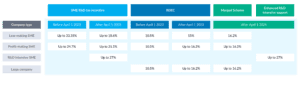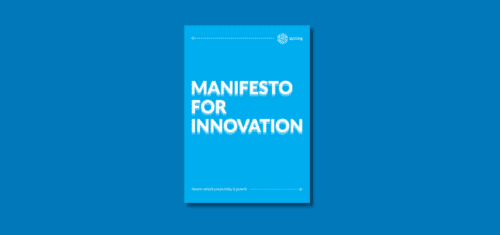The Autumn Statement of 2023 introduced significant changes to the UK’s R&D tax incentives, merging the SME and RDEC schemes into a single merged R&D scheme for accounting periods on or after 1 April 2024. This change marks a major shift in how businesses claim R&D tax relief, impacting both SMEs (small to medium enterprises) and large companies.
As Europe’s leading R&D tax consultancy, we specialise in helping businesses navigate these transitions. Our team provides tailored advice to ensure you remain compliant while making the most out of R&D tax relief available to you under the new scheme.
What is the merged R&D scheme?
The merged R&D scheme combines two of the UK’s primary R&D tax incentives:
- Enhanced tax relief and credits for SME expenditure;
- R&D Expenditure Credit (RDEC) for large companies, SME subcontractors, and subsidised projects
While it aims to simplify the process, the scheme introduces key changes that businesses must navigate, including how subcontracted and subsidised R&D is treated.
Who is affected?
All businesses currently claiming R&D tax relief will be impacted. Understanding where your business fall within the framework and the nature of your R&D activities will be crucial in adapting to these changes.
- SMEs must determine if they qualify for the R&D intensive scheme or fall under the merged scheme.
- Large companies need to consider new rules on subcontracted R&D and other adjustments.
Why was the merged R&D scheme introduced?
The UK government aims to simplify R&D tax incentives, boost private sector investment, and safeguard the scheme from abuse. This change marks the culmination of reforms since 2021, designed to stimulate economic growth through increased R&D investment.
What are the merged R&D scheme rates?
The table below shows the R&D tax relief rates over time and after the merged scheme.

How does the merged R&D scheme work?
The merged R&D scheme somewhat reflects the existing research and development expenditure credit (RDEC), but there are some key differences to note.
- All companies (excluding R&D intensive SMEs) are eligible to receive an above the line credit under the new scheme. This credit thus can offset against your tax liability, or is subject to an amendment, directly paid into your business.
- The merged scheme legislation incorporates the more generous version of the payable credit cap found in the current SME scheme. Learn more about the SME cap.
- Limitations on overseas R&D expenditure on externally provided workers (EPWs) and subcontracted R&D are also included in the new scheme.
Alongside these changes, contracted out R&D has significantly changed under the merged scheme, as outlined in the following section.
Understanding the changes to contracted out R&D
Subcontracted R&D is a complex area that played a key role in shaping the merged R&D scheme with the introduction of a clearer legislative definition of subcontracted R&D. The new approach aims to focus R&D tax relief on the company responsible for making R&D decisions and bearing the associated technological and financial risk.
Under the merged scheme, the rules governing subcontracted R&D are largely based on the SME scheme. Generally, companies won’t be able to claim RDEC if the R&D has been subcontracted to them by another company. However, businesses contracting third parties for R&D as externally provided workers (based in the UK) may still claim the qualifying costs.
These changes bring significant implications for both large businesses and SMEs, especially those involved in complex R&D supply chains. Large companies must assess how the new rules affect their commercial structures and contracts with external companies, while SMEs face potential uncertainty surrounding existing restrictions. Businesses currently claiming RDEC for subcontracted R&D are also likely to be impacted, as the contracting company will now claim the costs.
There are still certain scenarios where subcontractors can claim R&D tax relief, such as when the contractor is a non-tax-paying entity, like a charity, university, or overseas organisation. However, careful consideration of supply chain positions will be critical in navigating this evolving landscape.
Key points of reference for different businesses
Profit-making and non-R&D intensive loss-making SMEs
If your business allocates less than 30% of total expenditure to qualifying R&D, starting from your first accounting period on or after 1 April 2024, you’ll be required to claim R&D under the merged scheme. Key updates to consider include:
- A new mechanism for calculating relief.
- Revised rules for contracted out R&D.
- Limitations on eligible overseas expenditure for EPWs and subcontractors.
- The removal of restrictions on subsidised R&D expenditure.
Large companies, SME subcontractors and SMEs with subsidised R&D
While the merged R&D scheme builds on the existing RDEC model, it introduces several key changes that will impact large companies:
- New limitations on claiming R&D tax relief for activities contracted out to your business.
- Changes to the PAYE/NIC cap, affecting the amount of payable RDEC.
- Revised eligibility for payments to R&D subcontractors.
- Restrictions on overseas expenditure, specifically for externally provided workers (EPWs).
These changes require a careful review to ensure your claims remain optimised and compliant.
Loss-making, R&D-intensive SMEs
The enhanced rate introduced in April 2023 remains in place under the current SME model. If your business incurs qualifying expenditure from 1 April 2023 onwards, you may benefit from an 86% expenditure enhancement and a 14.5% payable credit.
From 1 April 2024, if 30% or more of your business expenditure is on R&D and you’re loss-making, you will continue to qualify for the enhanced rate, with a lower threshold than before. A one-year grace period protects businesses that temporarily fall below the 30% mark, ensuring stability for future planning. Additionally, restrictions on subsidised R&D have been lifted for qualifying businesses, providing further flexibility.
Explore the Enhanced R&D Intensive Support (ERIS) for more details.
Do you meet the 40% threshold?
For loss-making R&D-intensive SMEs meeting the 40% threshold, the SME scheme remains applicable beyond 1 April 2024. However, it’s essential to assess how the recent changes might impact your claims.
SMEs with R&D expenditure between 30% and 40% of total spend are eligible for the enhanced SME rate from their first accounting period starting on or after 1 April 2024.
Key factors to consider for these businesses include the updated definition of contracted-out R&D, limitations on overseas expenditure for EPWs and subcontractors, and the removal of restrictions on subsidised R&D expenditure.
How Ayming can help
Navigating these changes can be complex, but Ayming is here to support you. As R&D tax experts, Ayming is here to guide your business through these changes, from identifying eligible projects to optimising your claims under the new system. Our team of experts helps make the most from your R&D tax claims under the new framework and make sure you stay ahead of legislative updates.
Contact us today to learn how Ayming can help you transition seamlessly into the new merged R&D scheme and unlock the full potential of your innovation projects.




